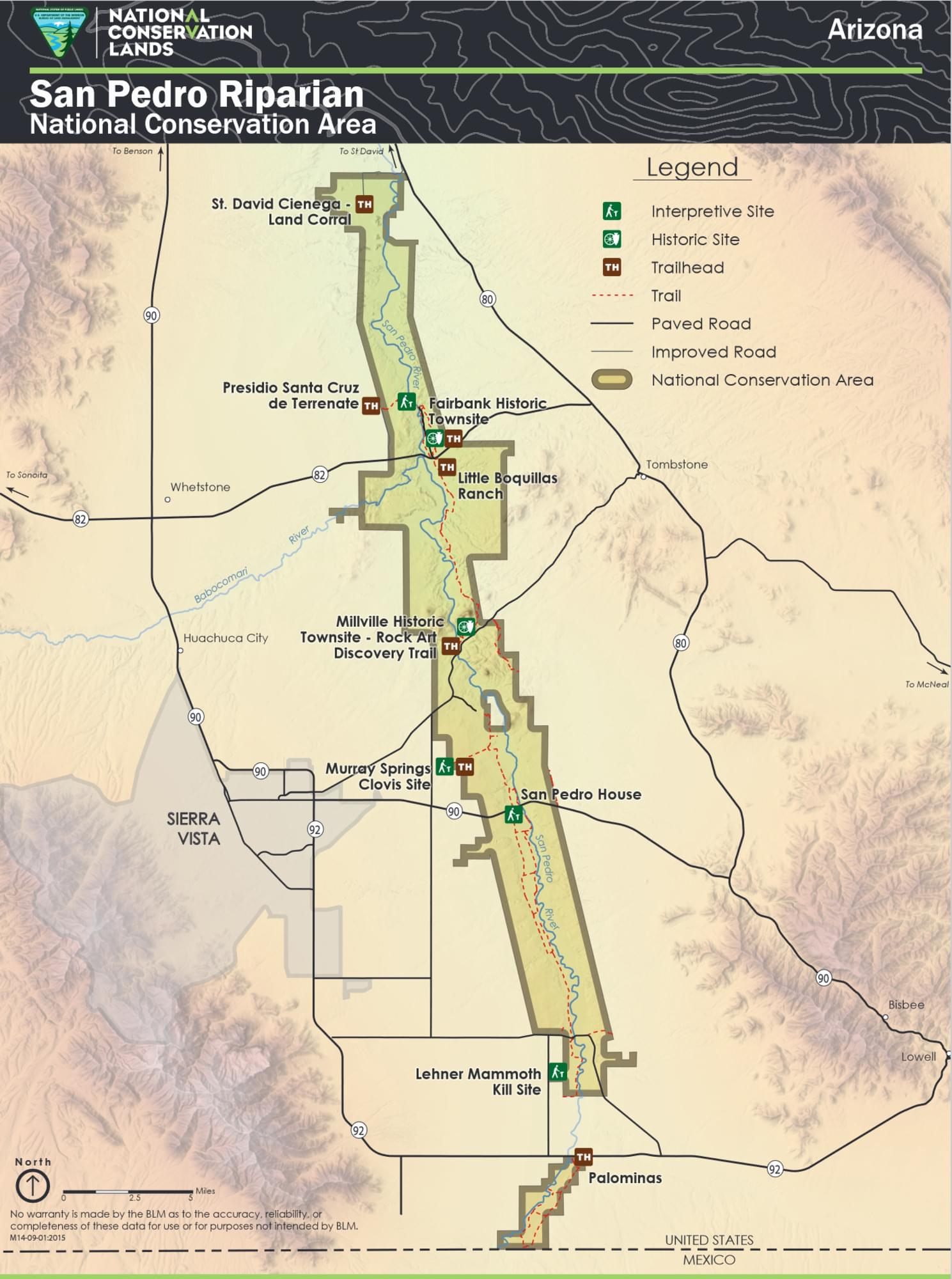San Pedro RNCA--Hereford Bridge
San Pedro RNCA--Hereford Bridge
Sierra Vista, Arizona 85650
San Pedro Riparian National Conservation Area Official WebsiteFriends of the San Pedro website
San Pedro Riparian National Conservation Area map
About this Location
The Hereford Bridge Trail is a portion of the long-distance San Pedro Trail offering visitors a diverse experience while traveling adjacent to the San Pedro River and into the San Pedro Riparian National Conservation Area. A delight to the senses, the diversity of birds, vegetation, and landscape features, will make this trip a journey worth savoring. Adjacent to the grasslands, the Fremont cottonwood-Goodding willow riparian forest is the most extensive riparian ecosystem remaining in the southwest. The BLM has protected this riparian habitat and the wildlife communities that thrive here, along with enhancing the opportunities for recreation, cultural interpretation, and education.
It is possible to hike from the Hereford Bridge all the way to the San Pedro House which is about ten miles along the river. A loop hike is possible by walking the old road bed north to Hunter Wash, then east to the river, and back south back to Hereford Bridge. The total distance of the loop is about eight miles.
The Hereford Bridge Trail is located within the San Pedro Riparian National Conservation Area, approximately 6 miles west of Sierra Vista, Arizona. From Sierra Vista, travel south on AZ-92 for 5 miles. Turn left onto East Hereford Road and travel east for approximately 9 miles until you arrive at the Hereford Bridge parking area.
About San Pedro Riparian National Conservation Area
See all hotspots at San Pedro Riparian National Conservation Area
The San Pedro Riparian National Conservation Area contains nearly 57,000 acres of public land in Cochise County, Arizona, between the international border and St. David, Arizona. The riparian area, where some 40 miles of the upper San Pedro River meanders, was designated by Congress as a Riparian National Conservation Area on November 18, 1988. The primary purpose of the special designation is to protect and enhance the desert riparian ecosystem, a rare remnant of what was once an extensive network of similar riparian systems throughout the American Southwest. One of the most important riparian areas in the United States, the San Pedro River runs through the Chihuahuan Desert and the Sonoran Desert in southeastern Arizona. The river’s stretch is home to more than 80 species of mammals, two native species and several introduced species of fish, more than 40 species of amphibians and reptiles, and 100 species of breeding birds. It also provides an invaluable habitat for 250 species of migrant and wintering birds and contains archaeological sites representing the remains of human occupation from 13,000 years ago.
The San Pedro Riparian National Conservation Area is located 6 miles east of Sierra Vista, Arizona. From Tucson, take I-10 east 40 miles to AZ-90. Follow the highway south through Huachuca City to Fry Boulevard in Sierra Vista. Follow this street for six miles east until you reach the San Pedro House. The San Pedro Riparian National Conservation Area can also be accessed via AZ-80, near St. David; AZ-82 to Fairbank; Charleston Road to Millville Historic Townsite; Hereford Road to Hereford Bridge; and AZ-92 to Palominas.
The area provides opportunities for wildlife viewing including birdwatching, picnicking, primitive camping, pre-historic and historic site visiting, hunting, hiking, fishing, biking, horseback riding, guided hikes, interpretive site visitation, and weekend children’s programs. Parking, interpretive kiosks, and trailheads are located at Fairbank, Murry Springs, San Pedro House, Land Corral, Terrenate, Millville, and Hereford Bridge. Parking and trailheads are also available at Hereford Road, Charleston Road, Palominas, Terrenate, Escapule, and Lehner. The Friends of the San Pedro lead regularly scheduled guided walks.
The national conservation area features the intact remains of the Spanish Presidio Santa Cruz de Terrenante, a Spanish fortress marking the northern extension of New Spain into the New World. The Murray Springs Clovis Site is a significant archaeological resource that contains evidence of the earliest known people to inhabit North America. An interpretive trail leads visitors to the site. The area also features the ruins of the old mining town of Fairbank. The San Pedro House, a 1930’s-era converted ranch house, serves as a bookstore and visitor center.
Content from Southeastern Arizona Bird Observatory website and San Pedro Riparian National Conservation Area webpage
